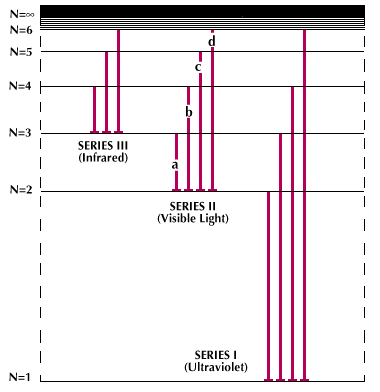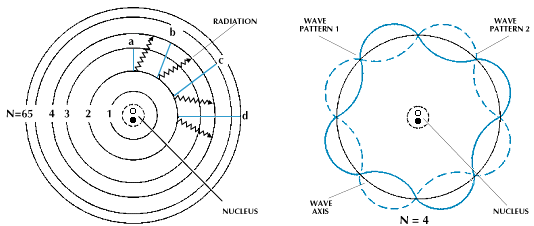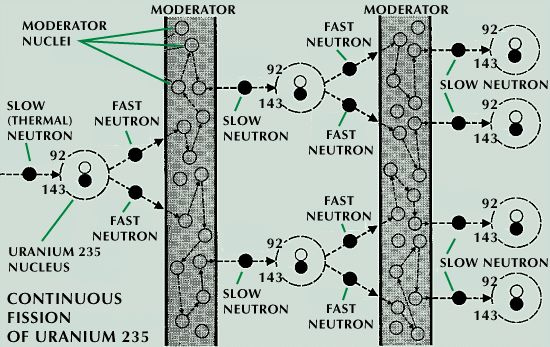Time Travel Research Center © 2005 Cetin BAL - GSM:+90 05366063183 - Turkey / Denizli
BASIC NUCLEAR SCIENCE
Mass and Atomic Numbers
Physical Properties of Atomic Particles
In many experiments in physics the weight of the entire nucleus is important. The atom is identified by the total number of protons and neutrons. This total is called a mass number. Neutrons, however, are not important in chemistry. The only part of the nucleus that is important to chemists is the proton that holds the electron. For this reason, atoms are commonly identified in chemistry by the number of protons in the nucleus. This is the atomic number of the element.
Another reason for identifying atoms by atomic number is the existence of isotopes. Every kind of atom (including hydrogen) can have different numbers of neutrons in its nucleus, making different isotopes of the element. The isotopes are distinguished by using the mass number, but the element is identified by the atomic number.
 This
model shows an atom of uranium with its electrons arranged in orbits called
shells. The labels on the orbits identify the shells by letter and give the
number of electrons in the shell. The composition of the central nucleus is
also indicated.
This
model shows an atom of uranium with its electrons arranged in orbits called
shells. The labels on the orbits identify the shells by letter and give the
number of electrons in the shell. The composition of the central nucleus is
also indicated.
The diagram of the uranium atom shows all these distinguishing factors. It is identified as uranium by the chemical symbol U and by the atomic number 92. It is shown as the isotope with 146 neutrons by the mass number 238. A table and diagram give atomic numbers for elements and mass numbers for isotopes.
Atomic Weights in Chemistry
In the days before the structure of the atom was known, chemists and other scientists developed a system of atomic weights for identifying atoms of the different elements. For the chemist it was enough to know how the various kinds of atoms compare in weight. First the lightest element, hydrogen, was assigned the arbitrary weight of one. Then equal amounts of other elements were measured against the hydrogen to obtain a table of relative atomic weights.
Because of isotopes these weights are not the actual relative weights of single atoms. In nature the various isotopes of each element are found in a certain proportional abundance. They differ only in their mass numbers. The atomic weight of the element is the average weight of the mixture of the element's isotopes. Hydrogen is a good example.
The natural abundance of normal hydrogen atoms without neutrons is about 99.985 per cent; the abundance of hydrogen atoms containing one neutron (atoms of the isotope deuterium) is about 0.015 per cent. The isotope tritium, containing two neutrons, occurs too rarely to consider. The weights of the two main isotopes in atomic mass units are 1.0078252 and 2.0141022, respectively. The two weights, considering relative abundance, give the average atomic weight of hydrogen, 1.00797.
How Protons and Neutrons Change
When the protons and neutrons in a nucleus of an atom are in a suitable ratio to each other, the nucleus shows no tendency to change, and the atom retains its chemical character. It is said to be stable.
Atoms of elements heavier than lead or bismuth (atomic numbers 82 and 83) are radioactive, because the nucleus is unstable. Atoms of light elements such as carbon can also be made unstable by bombardment with nuclear particles. Carbon, for example, has two stable isotopes, each with six protons and six or seven neutrons (6C12 and 6C13). Atoms of unstable carbon 14 (6C14) can be produced by bombardment, either in nature with cosmic rays or with high-powered laboratory devices.
The nucleus cannot, however, hold the second excess neutron indefinitely. It gains a more normal neutron-proton balance by expelling an electron. The electron's charge apparently comes from changing a neutron to a proton. This changes carbon 14 to an isotope of nitrogen (6C14 becomes 7N14). The atomic number of the new element changes from 6 to 7. The mass number (14) is the same, because the loss of a neutron is balanced by the gain of a proton.
An opposite change occurs if bombardment drives out one or two neutrons from normal carbon atoms, making carbon with mass number 11 or 10. The remaining neutrons can hold all six protons for only a few minutes or seconds. The nucleus, however, does not expel protons. It expels a particle called a positron. This has the mass of an electron but a positive charge. The charge seems to come from changing a proton to a neutron. The expulsion changes carbon 11 and 10 to isotopes of boron (5B11 and 5B10).
Electron Shells and Chemical Activity
Electrons draw atoms into chemical reactions by forming pairs with electrons from the outer edges of other atoms. In heavier atoms most of the electrons are arranged in a way that binds them firmly to the atom. They cannot enter into chemical reactions. Electrons arrange themselves in a series of shells around the nucleus. The electrons in each shell tend to repel each other, but they overcome this repulsion in part by forming pairs within the shells.
The simplest example of this is the helium atom. Around its nucleus of two protons and two neutrons (2He4) it has a pair of electrons. All the atomic forces are completely satisfied, making the helium atom the most strongly bound of any in nature. It will not form two-atom molecules, and it shows no chemical activity. All heavier atoms have a helium pair around the nucleus, and additional electrons circle outside this pair. Some of these can pair with electrons from other atoms until this shell has four pairs. This again satisfies all atomic forces, and the atom (of argon) is chemically inert. Additional shells have more complex arrangements.
The structure and chemical activity of electrons were revealed by studies of light with spectroscopes and of crystals of solid matter with X rays. Scientists who used X rays named the shells with letters beginning with K, to avoid confusion with other systems of labeling. Since chemical properties arise from an atom's outer electrons, they vary as the different shells are built up. The periodic table of the elements used in chemistry corresponds roughly to the shells. The principal periods end exactly where the X-ray shells do, with an atom that has four paired electrons in its outer shell.
The Energy Within the Atom
 This
image is the line spectrum of the hydrogen atom. Lines a, b, c, and d
represent the wave lengths (in Angstrom units) of visible light emmitted by
the atom when the electron falls through corresponding paths on the energy-level
diagram.
This
image is the line spectrum of the hydrogen atom. Lines a, b, c, and d
represent the wave lengths (in Angstrom units) of visible light emmitted by
the atom when the electron falls through corresponding paths on the energy-level
diagram.
The orbits made by electrons rotating in their shells are shown in the diagrams as circles. Actually their paths form far more complicated patterns. Most of the knowledge of the electron structure of atoms has been obtained by the study of the light and X rays given out by atoms. Light is emitted by the atom when it is excited by high temperatures. This emission consists of lines of definite wave lengths. This unique combination of lines is called the line spectrum of the element. It can be recorded and measured.
Careful analysis of line spectra of elements began about 1880. The quantum theory was proposed by Max Planck in 1900 and modified by Albert Einstein in 1905. Niels Bohr successfully applied this theory to explain the hydrogen spectrum in terms of the electronic structure of the hydrogen atom.
The Bohr Model of the Hydrogen Atom
The hydrogen atom is selected for study because it has the simplest atomic structure. As the single electron whirls around the nucleus, it is attracted to the nucleus by the electrostatic force of unlike charges. It is also acted upon by a centrifugal force that tends to pull it away from the nucleus. When these two forces balance, the electron moves in its most stable orbit. The most stable state is called the ground, or normal, state of the atom. It represents the condition of minimum possible energy for the atom. It is assumed that, in this state, the electron may revolve without radiating energy.
There are only certain energy states in which the hydrogen atom can exist. If the atom absorbs more energy from an outside source, it is then considered to be in an excited state. An excited state, compared to the ground state, is less stable but possesses more energy. The reverse action also takes place. When an atom in an excited state falls to the ground state, energy is lost in the form of radiation. There can be only certain excited states because of the quantities in which energy is exchanged. Emission or absorption of energy occurs in specific amounts called quanta. A quantum is a specific amount of energy. Every energy exchange must involve at least one quantum of energy or some whole number multiple of one quantum. If the amount of energy available for exchange is less than one quantum, no exchange can occur.
The Energy Level Diagram
A physical representation of this energy exchange can be shown by an
energy level diagram.
 The energy
level diagram for hydrogen. N=1 is the ground state of the atom. All other
values of N represent various excited states. When an electron falls through
paths a, b, c, or d, the atom emits visible light.
The energy
level diagram for hydrogen. N=1 is the ground state of the atom. All other
values of N represent various excited states. When an electron falls through
paths a, b, c, or d, the atom emits visible light.
If the atom absorbs energy, the orbit of the electron increases because the atom is in an excited state. If the atom emits energy, the electron falls into a more stable orbit closer to the nucleus. The diagram can be constructed by representing various energy levels (or states) with horizontal lines. The emission of light accompanying the fall of an electron from one energy level to a lower energy level is shown on the diagram by a line drawn between the corresponding energy levels. When the electron falls from an outer to an inner orbit, the atom emits light. The energy of the emitted light is equal to the energy lost by the electron in its fall. The light may be ultraviolet, visible, or infrared. In the visible range it appears as a series of lines.
The theory of wave, or quantum, mechanics modifies the Bohr theory to account for both the particle and wave characteristics of the electron. This theory appears today to explain more completely the motions and energy exchanges of electrons.
 The Bohr
theory sees an electron (left side diagram) as a point mass occupying
certain energy levels. Wave mechanics sees an electron as a wave washing
back and forth in the atom in certain patterns only. The wave patterns and
energy levels correspond exactly.
The Bohr
theory sees an electron (left side diagram) as a point mass occupying
certain energy levels. Wave mechanics sees an electron as a wave washing
back and forth in the atom in certain patterns only. The wave patterns and
energy levels correspond exactly.
The Atomic Nucleus
The nucleus of an atom is composed of specific numbers of protons and neutrons, called nucleons. The mass of the nucleus is slightly smaller than the sum of the masses of its protons and neutrons. This difference is known as the mass defect and is related to an equivalent energy, called the binding energy. This relation, based on Einstein's statement for the equivalence of mass and energy, is E = mc2, where E = energy, m = mass, and c = the speed of light. It means that energy can be transformed into mass and mass can be transformed into energy. The atomic mass unit (amu) corresponds to a multiple of an energy unit called the electron volt. Mass-energy calculations are usually expressed in million electron volts (MeV). The equivalence is 1 amu = 931 MeV.
 U-235
captures slow neutrons much more frequently than fast neutrons. Fission
produces fast neutrons. These lose energy in bouncing against moderator
nuclei and emerge as slow neutrons to split more U-235 nuclei.
U-235
captures slow neutrons much more frequently than fast neutrons. Fission
produces fast neutrons. These lose energy in bouncing against moderator
nuclei and emerge as slow neutrons to split more U-235 nuclei.
The mass defect or binding energy per nucleon is different for various elements. It has the least value for light elements, such as deuterium, or heavy hydrogen. The deuterium mass is less than the mass of its constituents of one proton and one neutron by about 2 MeV. For heavier elements, the mass defect per nucleon first increases to a maximum and then decreases. Thus if a heavy nucleus, such as uranium-235 (U-235) is split into fragments consisting of lighter elements, the sum of the mass defects of the fragments is found to be larger than that of the original U-235 nucleus. The difference is the energy released during the fission process. In the fusion process two light nuclei are joined to form a heavier element, also releasing larger amounts of energy. The final mass of the element is less than the mass of the two original nuclei.
The NUCLEAR ENERGY page was created by
Glen McInnis for the
Physics 261 web project.
Recommended viewing resolution is: 800x600 or better
Alıntı: http://www.upei.ca/~physics/p261/projects/nuclear2/basicsci.html
Hiçbir yazı/ resim izinsiz olarak kullanılamaz!! Telif hakları uyarınca bu bir suçtur..! Tüm hakları Çetin BAL' a aittir. Kaynak gösterilmek şartıyla siteden alıntı yapılabilir.
The Time Machine Project © 2005 Cetin BAL - GSM:+90 05366063183 -Turkiye/Denizli
Ana Sayfa /index /Roket bilimi /![]() E-Mail /CetinBAL/Quantum Teleportation-2
E-Mail /CetinBAL/Quantum Teleportation-2
Time Travel Technology /Ziyaretçi Defteri /UFO Technology/Duyuru